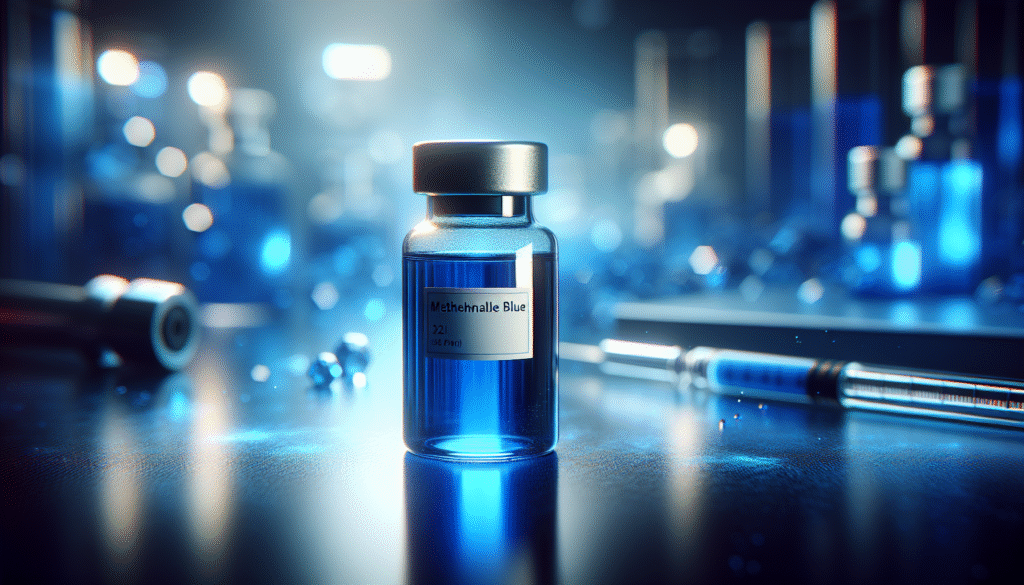
Have you ever wondered how certain substances can influence the aging process? As science continues to advance, researchers are making significant discoveries about how we can potentially slow down, or even reverse, the effects of aging. One such substance making waves in the realm of anti-aging research is Methylene Blue. This fascinating compound has caught the attention of scientists and health enthusiasts alike. In this article, we will uncover the properties of Methylene Blue and its promising applications in anti-aging.
What is Methylene Blue?
Methylene Blue is a synthetic dye that has been used in various medical applications for over a century. Originally developed as a textile dye in the late 19th century, it has found uses in treating conditions such as methemoglobinemia, a blood disorder, and as a medication for various infections. Beyond its medical applications, Methylene Blue has gained popularity in recent years for its potential anti-aging effects and neuroprotective properties.
The Chemical Structure of Methylene Blue
Methylene Blue, known chemically as methylthioninium chloride, features a complex structure that allows it to intersect with several biological pathways. With its aromatic rings and positive charge, this compound can easily penetrate cell membranes, making it effective at influencing cellular processes.
Historical Uses
The usage of Methylene Blue spans over a hundred years. Initially, it was embraced as a treatment for malaria, before researchers discovered its potential benefits in treating methemoglobinemia. Its ability to enhance oxygen transportation in the blood has led to its incorporation in various medical applications, including psychiatric therapies, thereby laying a strong foundation for its recent exploration in the anti-aging domain.
The Mechanism Behind Methylene Blue’s Effects
Understanding how Methylene Blue operates at a cellular level is essential in appreciating its potential benefits for anti-aging. Mainly, its interaction with mitochondria—the powerhouse of the cell—sets it apart from many other compounds.
Mitochondrial Health
Mitochondria play a crucial role in cellular energy production, and their decline is associated with aging and various age-related diseases. Methylene Blue has been shown to enhance mitochondrial function by aiding in the electron transport chain. This means it can help cells produce energy more efficiently, which is fundamental in sustaining cellular vitality.
Reactive Oxygen Species (ROS) Management
With age, the production of reactive oxygen species (ROS) increases, leading to oxidative stress that can damage cellular components. Methylene Blue exhibits antioxidant properties, which can help neutralize these harmful ROS, thus protecting cells from oxidative damage.
Anti-Apoptotic Properties
Apoptosis, or programmed cell death, becomes dysregulated with age, contributing to various degenerative diseases. Methylene Blue’s anti-apoptotic effects involve the modulation of specific signaling pathways, potentially leading to increased cellular lifespan and health.
Neuroprotective Benefits
In addition to enhancing mitochondrial health, Methylene Blue has demonstrated neuroprotective properties. Research studies indicate that Methylene Blue can protect neurons from degeneration, making it a candidate for neurological disorders such as Alzheimer’s disease and Parkinson’s disease.

Current Research on Methylene Blue and Aging
The current research landscape regarding Methylene Blue is both vast and complex. A multitude of studies are investigating its potential applications and benefits in relation to aging, and the results are increasingly compelling.
Cellular Studies
In vitro studies—conducted in controlled environments outside living organisms—have shown that Methylene Blue can improve ATP production in aged human cells. This finding highlights its potential to rejuvenate cellular energy levels, which decline with age.
Animal Studies
Research in animal models has also produced promising outcomes. Studies have indicated that Methylene Blue can extend lifespan and improve cognitive functions in mice. These results point toward the potential of Methylene Blue as a therapeutic agent in combating the aging process.
Human Trials
While animal studies are promising, human trials are crucial to ascertain the safety and efficacy of Methylene Blue in anti-aging applications. Some early-phase human studies have suggested cognitive enhancement with Methylene Blue administration, but further investigations are necessary to draw definitive conclusions.
| Study Type | Subject | Findings |
|---|---|---|
| In Vitro | Human Cells | Increased ATP production in aged cells |
| Animal | Mice | Lifespan extension and cognitive improvement |
| Human | Initial Trials | Cognitive enhancement reported in small populations |
Mechanisms at Play in Aging
Aging is a multifaceted biological process influenced by various genetic and environmental factors. By targeting mitochondria, ROS, and apoptosis, Methylene Blue addresses some of the key pathways responsible for age-related cellular decline. This multifactorial action could set Methylene Blue apart from traditional anti-aging therapies.
Real-Life Applications
While the research is ongoing, there are several practical applications of Methylene Blue worth exploring. Understanding these applications can inform your approach to anti-aging practices.
Supplementation
Methylene Blue is becoming increasingly available as a supplement. The question arises: should you consider incorporating it into your routine? Preliminary studies suggest that low-dose Methylene Blue may provide neuroprotective benefits and enhance cognitive functions, but professional guidance is essential before introducing any supplement into your regimen.
Dosage and Administration
The appropriate dosage of Methylene Blue for anti-aging purposes is not yet established. Most studies have utilized doses ranging from 0.5 mg to 8 mg per kilogram of body weight. However, consulting with a healthcare professional is critical before taking Methylene Blue, particularly as self-medication can lead to unforeseen consequences.
Combination with Other Therapies
Methylene Blue may work synergistically with other anti-aging therapies. For example, combining it with antioxidants or other mitochondrial-targeting supplements might enhance effectiveness. However, more research is necessary to determine the safety and efficacy of these combinations.
Neurodegenerative Diseases
The neuroprotective properties of Methylene Blue hold promise for individuals at risk of neurodegenerative diseases. This could lead to innovative treatments for conditions like Alzheimer’s and Parkinson’s, where preserving cognitive function is paramount.
| Application | Description |
|---|---|
| Supplementation | Methylene Blue is available as a supplement, but professional guidance is essential. |
| Neurodegenerative Diseases | Potential use in treatment protocols for cognitive decline and neuroprotection. |
| Combination Therapies | It may enhance the efficacy of other anti-aging treatments when used in conjunction. |

Safety and Side Effects
As with any substance, understanding the safety profile of Methylene Blue is essential before considering its use. Data regarding side effects is limited but noteworthy.
Common Side Effects
Methylene Blue may cause side effects, particularly when taken in higher doses. Commonly reported side effects include:
- Nausea
- Headaches
- Dizziness
- Skin discoloration (due to its dye nature)
While most side effects are relatively mild, they can be bothersome. Ensuring proper dosing and discussing any pre-existing health conditions with a healthcare provider is highly advisable.
Possible Drug Interactions
Methylene Blue is known to interact with various medications, including certain antidepressants and medications affecting serotonin levels. As such, it is crucial to discuss any ongoing medications with your physician to avoid potential interactions.
Contraindications
Certain individuals should refrain from using Methylene Blue. These include:
- Pregnant or breastfeeding women
- Individuals with severe kidney or liver impairment
- People with hypersensitivity to Methylene Blue or related compounds
Ensuring you account for these contraindications can help you make informed decisions regarding Methylene Blue use.
The Future of Methylene Blue in Anti-Aging Research
The scope of research surrounding Methylene Blue is promising, with numerous studies underway to better understand its influence on aging. Future investigations will likely explore its efficacy in combination therapies, optimal dosing, and its long-term effects.
Potential Breakthroughs
As ongoing studies yield results, you may see new applications for Methylene Blue emerge, particularly in the realm of personalized medicine. As research further delineates its mechanisms, healthcare professionals may tailor treatments based on individual genetic and environmental factors.
Expanding the Research Landscape
As Methylene Blue gains traction within the scientific community, its exploration in anti-aging research may expand further. Collaboration among researchers globally could lead to a deeper understanding of how to maximize its benefits.
Ethical Considerations
Although the enthusiasm surrounding Methylene Blue is palpable, ethical considerations regarding its use in healthy individuals versus those with age-related diseases must be accounted for. Ensuring that research adheres to ethical standards while balancing scientific inquiry is paramount.
Conclusion
The exploration of Methylene Blue as a breakthrough in anti-aging research marks an exciting chapter in the scientific community. By understanding its properties and mechanisms, individuals may find new avenues to enhance their longevity and overall well-being. As research continues to evolve, remaining vigilant and informed allows you to navigate the myriad of options in the anti-aging landscape effectively. While much work remains to be done, Methylene Blue serves as a beacon of hope for those seeking to mitigate the effects of aging and promote a healthier future.
Take Action
If you are considering incorporating Methylene Blue into your health regimen, approach it with caution. Engage in discussions with healthcare professionals, conduct thorough research, and follow emerging studies closely. By doing so, you empower yourself to make informed decisions regarding your journey against aging. While the path may not always be clear, staying knowledgeable and proactive is key to harnessing the potential benefits of Methylene Blue in anti-aging.